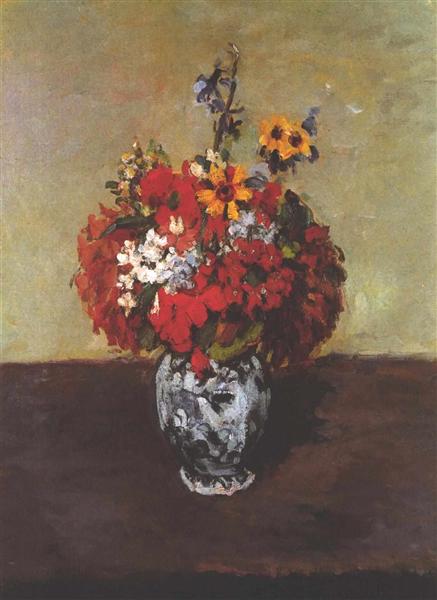Beskrivelse
Paul Cézanne's Dahlias in a Delft Vase, painted in 1885, is a fascinating example of the synthesis between naturalistic observation and subjective exploration of color and form, fundamental characteristics of the post-impressionist master's style. In this painting, Cézanne presents a vibrant bouquet of dahlias pouring their essence into an elegant Delft vase, evoking the rich tradition of Dutch ceramics, while around them unfolds an environment that seems both real and interpreted.
The composition is characterized by balance and harmony. The dahlias, with their exuberant display of petals, appear in a variety of shades ranging from pale pinks to deep crimsons, giving the work a unique vibrancy. Cézanne uses a technique of visible and modular brushstrokes, creating volume and texture that invite the viewer to explore the depth of each flower. Through their shape and color, the dahlias become the focal point of the work, while the Delft vase provides a visual contrast with its combination of blues and whites, emphasizing the richness of the flowers and framing their beauty in an elaborate setting.
The use of color in this work is particularly masterful. Known for his bold use and understanding of color as a structural element, Cézanne employs warm and cool tones in a delicate balance that provides depth and dimensionality. The shadows on the petals are subtle, yet effective, supporting the shape of the flowers, while the background, though less detailed, is loaded with color, adding an atmospheric effect that makes the dahlias pop even more. This focus on the interplay between colors is one of the aspects that sets Cézanne apart from other contemporaries, as it creates a dynamic visual experience that seduces the viewer.
As for the absence of human figures in this work, it is important to recognize that Cézanne, like many of his contemporaries, often moved away from portraiture and the figure, focusing instead on nature and everyday objects. Through this choice, he manages to make the flowers take on a life of their own, transcending their mere representation of natural elements to become a symbol of sensitivity and beauty. The dahlias, with their various shapes and colors, can be interpreted as a reflection on life itself, its fragility and transience, recurring elements in Cézanne's work, who explores the notion of transformation through nature.
"Dahlias in a Delft Vase" reflects Cézanne's desire to capture the essence of nature, as well as his search for a new form of visual representation that moved away from the academic conventions of his time. This work falls within Cézanne's trajectory towards innovation, as his style begins to break down forms into a more abstract language that would influence later artistic movements. Appreciating this painting is also an invitation to contemplate how art can distort reality to offer a new interpretation, one that celebrates the depth of color and form.
In short, “Dahlias in a Delft Vase” is not only a testament to Cézanne’s technical mastery, but also an exploration of human emotions and aesthetic experience through nature. As we approach this sublime work, we become participants in its world, reminded of the ephemeral beauty of flowers and the unbreakable connection between art and life.
KUADROS ©, a famous painting on your wall.
Hand-made oil painting reproductions, with the quality of professional artists and the distinctive seal of KUADROS ©.
Painting reproduction service with satisfaction guarantee. If you are not completely satisfied with the replica of your painting, we will refund 100% of your money.

